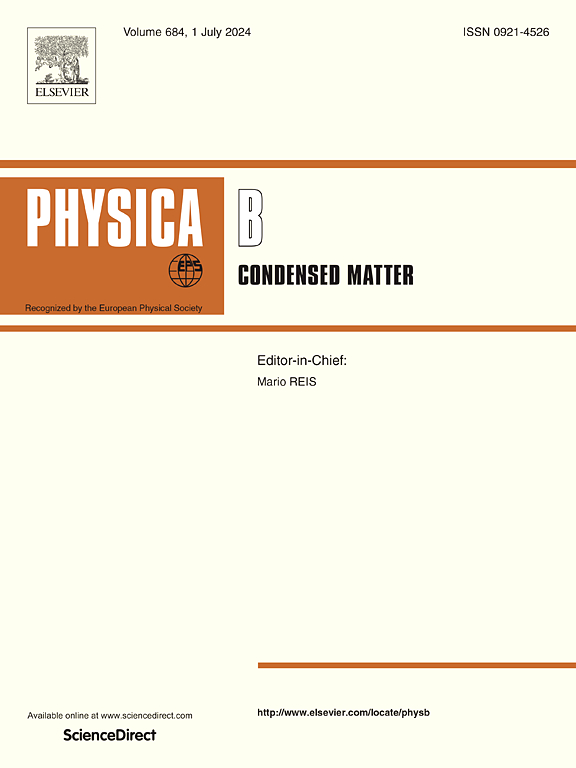First-principles analysis for electronic and optical properties of silicon doped with transition metals (Ti, V, Cr)
IF 2.8
3区 物理与天体物理
Q2 PHYSICS, CONDENSED MATTER
引用次数: 0
Abstract
Silicon, a material of significant value in the fields of optoelectronics and microelectronics, has experienced a marked increase in demand for its use in silicon photonics. Driven by the increasing demand, various materials, especially transition metals, have been doped into the silicon lattice to enhance its photon sensitivity and expand its infrared applications. In this study, the electronic and optical properties of three popular transition metals (Ti, V, Cr) doped silicon (M − Si) are systematically investigated using first-principles calculations. The atomic structures, formation energies, energy band structures, and spectral absorption characteristics of M − Si at various doping concentrations and occupied positions are examined. The results show that a substantial sub-bandgap absorption can be augmented by intermediate band (IB) assistant photon transition and hybridization of IB with CB or VB. The enhancement in sub-bandgap absorption is influenced by the variation of bandwidths and positions of the IB induced by different doping elements and occupations. The study further concluded that Ti is more suitable for silicon doping due to its combination of a deep-level impurity property, lowest formation energy, and the most significant sub-bandgap absorption. The present study provides both guidance and theoretical basis for the experimental fabrication of optimized transition metal-doped silicon materials.
过渡金属(Ti, V, Cr)掺杂硅的电子和光学性质第一性原理分析
硅是一种在光电子学和微电子学领域具有重要价值的材料,其在硅光子学中的应用需求显著增加。在需求增长的驱动下,人们在硅晶格中掺入各种材料,特别是过渡金属,以提高其光子灵敏度,扩大其红外应用。在这项研究中,系统地研究了三种常见的过渡金属(Ti, V, Cr)掺杂硅(M−Si)的电子和光学性质。研究了不同掺杂浓度和不同掺杂位置下M - Si的原子结构、形成能、能带结构和光谱吸收特性。结果表明,中间带(IB)辅助光子跃迁和IB与CB或VB的杂化可以增强大量的亚带隙吸收。亚带隙吸收的增强受不同掺杂元素和职业引起的IB的带宽和位置变化的影响。该研究进一步得出结论,由于Ti具有深层杂质性质,最低的形成能和最显著的亚带隙吸收,因此更适合硅掺杂。本研究为优化过渡金属掺杂硅材料的实验制备提供了指导和理论依据。
本文章由计算机程序翻译,如有差异,请以英文原文为准。
求助全文
约1分钟内获得全文
求助全文
来源期刊

Physica B-condensed Matter
物理-物理:凝聚态物理
CiteScore
4.90
自引率
7.10%
发文量
703
审稿时长
44 days
期刊介绍:
Physica B: Condensed Matter comprises all condensed matter and material physics that involve theoretical, computational and experimental work.
Papers should contain further developments and a proper discussion on the physics of experimental or theoretical results in one of the following areas:
-Magnetism
-Materials physics
-Nanostructures and nanomaterials
-Optics and optical materials
-Quantum materials
-Semiconductors
-Strongly correlated systems
-Superconductivity
-Surfaces and interfaces
 求助内容:
求助内容: 应助结果提醒方式:
应助结果提醒方式:


